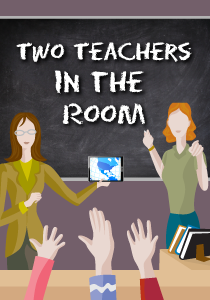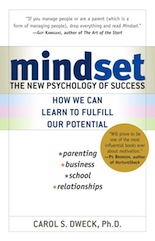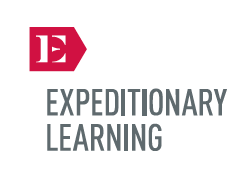Inclusion Classrooms: Cultivate a Growth Mindset
A MiddleWeb Blog

Do you see constructive criticism as a possibility for learning and growth or as a reminder of an area where you are not strong? Do you think your areas of weakness may become areas of strength with hard work, persistence, and dedication to practice?
If so, you probably have a “growth mindset.” What about your students? Are you guiding them toward a growth or a fixed mindset?
This blog post is sparked by my daily passion to guide my students toward reaching their personal best by becoming life-long, strategic learners — as well as my connection to a recent professional development experience provided by my district.
This past Friday was Superintendent’s Conference Day in my district. Colleagues and I had the opportunity to be inspired by Kate Gerson, a Senior Regents Research Fellow for the Common Core with the New York Regents Research Fund. We knew she was going to speak about the Common Core State Standards. But we were given the chance to leave the session with so much more.
Oh, the possibilities!

Kate connected with all who were willing to affirm their beliefs about learning and all who were willing to extend and perhaps even open their minds to a new way of thinking. Throughout the presentation, I connected, I affirmed, and I became inspired to think about more ways to collaborate with colleagues to make this a natural, consistent experience for students in our district.
And then, of course, I began to get giddy thinking about the value of the growth mindset in inclusion classrooms. Oh, the places students can go—if only the co-teachers in the room would create learning experiences through the lens of a growth mindset!
Before I get into my takeaways from this professional development experience, here’s some background from another presentation where Kate speaks at the Network Team Institute held in August 2012. She addresses the process of implementing the Common Core State Standards with a focus on applying a growth mindset. Check out part one here. And here’s part two.
My Two Main Takeaways
1. Teachers must raise awareness about the value of a growth mindset with parents.
Here are just a few ways teachers can spread the word to parents:
► Send information home for parents to read.
► Include links to learn about the mindsets through email, class websites, etc.
► Present at PTA meetings.
► Include in your Meet the Teacher Night at the beginning of the year—and be sure to follow up with evidence of the benefits throughout the year.
► Involve parents in sharing what goes on at home in order to foster a growth mindset.
► Keep communication open—and share evidence of the powerful learning that happens when a growth mindset is solidly in place.
2. Teachers Must Focus on Teaching Practice—Not Test Prep
Here’s what teachers can do:
► Guide students to deepen their background knowledge. Build their willingness to interact with text.
► Teach academic vocabulary.
► Incorporate Domain Specific Acceleration, which adopts the research-supported idea that the more you read something, the more you can read about that something because you have developed the vocabulary base and background knowledge.
► Remember that as you incorporate academic vocabulary, it shows up in other domains, which will lead to successful reading experiences.
► Adopt a mastery paradigm—guide students to see that when you’re working toward mastery, you are growing. It’s not about the grade—it’s about the learning process. Learning from mistakes can be a richer learning experience than having an A slapped on the top of an assignment.
► Teach students to move through the frustration of genuine learning. Get them to see that becoming successful in a skill often involves confusion, frustration, hard work, and lots of practice! For example, for students who struggle with reading, teach them strategies—provide lots of practice at their independent level—do not enable by allowing them to avoid the task, or reading to them all the time. Help them to push through their frustration They will thank you later (maybe much later), and it will be worth the struggle and effort!
► Draw that strategic line between advocating/supporting students and enabling dependency. For example, teachers should ask themselves, how much background knowledge do I really need to provide for my students for this lesson? The question becomes how will you inspire students to get the information on their own—with the appropriate levels of scaffolding.
► Examine the types of scaffolds you have in place. Are they guiding independent thinkers? Or producing students who are dependent on the well-intentioned scaffold as crutch? For example, how do you handle class notes: do students just sit and wait for them to be given? Or do they jot down key words, using a guided note-taking strategy?
A Few Strategies to Support a Growth Mindset State of Mind

► A strategy I return to time and time again is called Possible sentences. Check it out—see what you think. If you don’t have time to check out the link right now—take a sneak peek here to get the gist.
► Another one of my all-time favorites that works with any grade level and any genre or text is reciprocal teaching. Students work through a text by learning to Predict, Question, Clarify, and Summarize, while collaborating with peers. Here’s a quick link to a graphic organizer for those short on time at the moment.
For co-teachers, the growth mindset is a necessary paradigm to instill. It should be second nature as we guide students to close personal achievement gaps in order to keep up with the pace and rigor of the general education setting. Co-teachers must develop a sense of urgency around guiding students to push through frustration. Teachers should support/advocate in ways that help students to know that it’s OK to step out of their comfort zones in order to learn from mistakes and to grow.
But first, perhaps, teachers need to do that for themselves. So, please do! And then come back here and share your questions, your celebrations, and your journey…
As for this post, I’m thankful to be part of a district that strives to provide meaningful professional development to keep us moving forward. And a special thanks to Kate Gerson for giving me the opportunity to connect my passion and beliefs with your willingness to share and inspire—for this blog post and beyond!
Now for the best part…let’s chat! We have so much to learn together….
In what ways do you connect with a growth mindset?
What value do you place on instilling a growth mindset in your classroom?
What state or other web-based resources serve to support your instructional practice?




































Great Blog! I am an advocate for families with children with special needs. I look forward to becoming a regular reader of your blog! I enjoy the insight and value the tips. Thanks again.
Doug H.
Eugene OR
Doug, thanks for your comment. I connect with your enthusiasm and dedication! I am looking forward to future collaborations!
Something you may be interested in taking a look at. I’ve been a Dweck fan for years. Check out her book geared more at educators, Self-Theories.
Thanks for sharing, Carolyn! Here’s another link of interest–A quick reference to some Carol Dweck quotes– at a glance.
http://www.goodreads.com/author/quotes/217172.Carol_S_Dweck
enjoy!